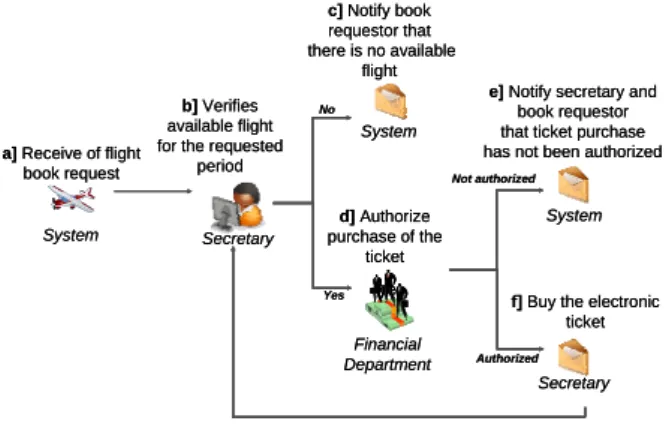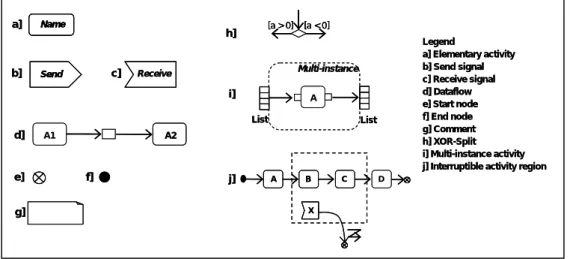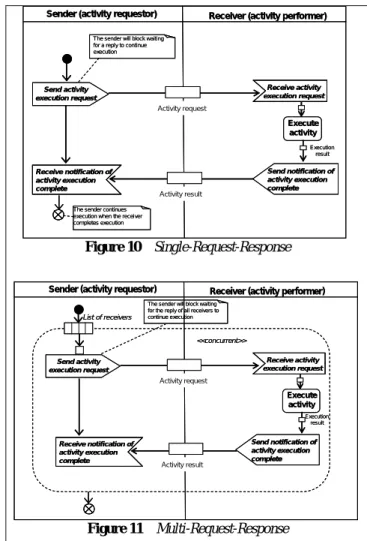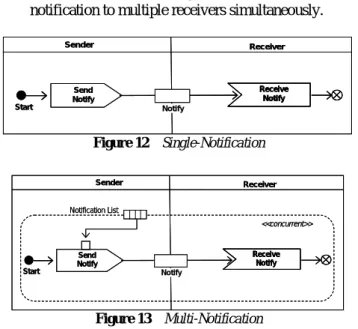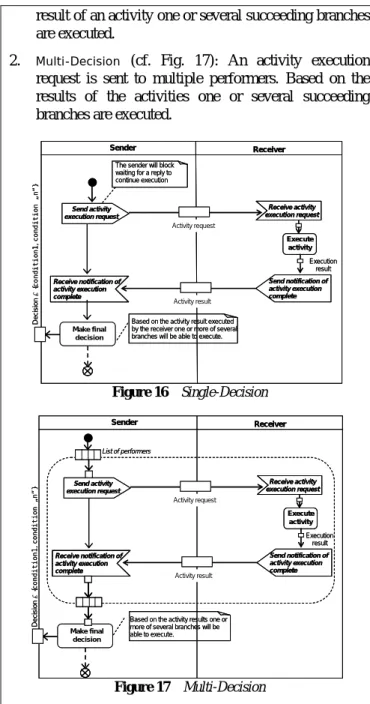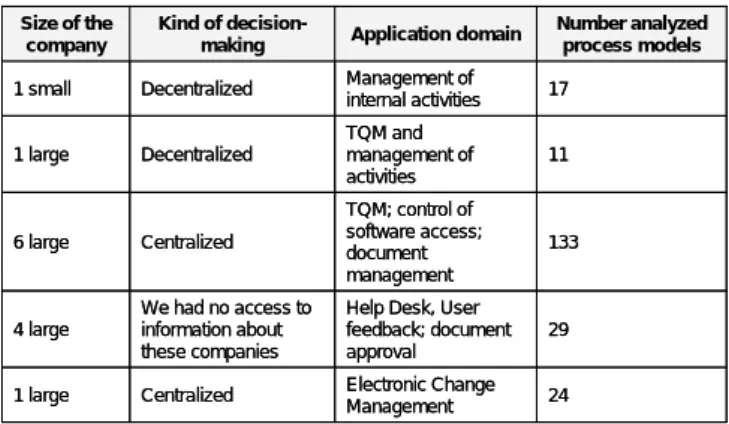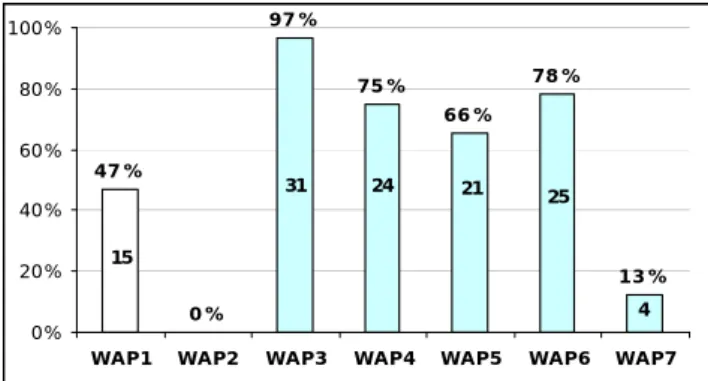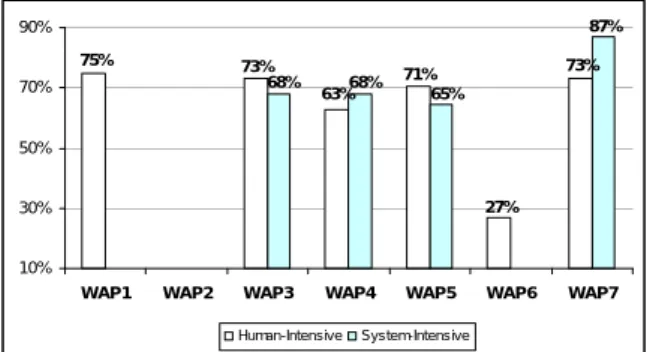Activity Patterns in Process-aware Information Systems: Basic Concepts and Empirical Evidence
Lucinéia Heloisa Thom
*, Manfred Reichert
Institute of Databases and Information Systems,
Ulm University, James-Frank-Ring, 89069 Ulm, Germany E-mail: {lucineia.thom, manfred.reichert@uni-ulm.de}
*Corresponding author
Cirano Iochpe
Institute of Informatics,
Federal University of Rio Grande do Sul, Porto Alegre, Brazil E-mail: ciochpe@inf.ufrgs.br
Abstract: Recently, a variety of workflow patterns was suggested for capturing different aspects in process-aware information systems (PAISs) including control and data flow, resources, process change, and exception handling. All these patterns are highly relevant for implementing PAISs and for designing process modeling languages. However, current patterns provide only a partial answer to the question which business functions a designer might want to reuse when modeling processes. This paper presents a revised version of a collection of activity patterns to deal with this challenge. Each of them is related to a recurrent business function as it can be frequently found in process models (e.g., task execution request, notification, approval). We describe the identified activity patterns and their variants in detail. The main purpose of our paper is to discuss results from empirical studies, in which we analyzed more than 200 process models in order to evidence the practical relevance of the patterns. This includes a detailed analysis of the context in which activity patterns occur as well the frequency of this occurrence. These empirical findings can be used for the design of more intelligent, pattern-based process modeling tools.
Keywords: workflow activity patterns; business functions; business process management;
business process modeling.
Reference to this paper should be made as follows: Thom, L.H., Reichert, M., Iochpe, C.
(2009) ‘Activity Patterns in Process-aware Information Systems: Basic Concepts and Empirical Evidence’, Int. J. Business Process Integration and Management.
Biographical notes:
Lucinéia Heloisa Thom is a visiting scientist at the University of Ulm in the group of Manfred Reichert. She received a Bachelor degree in Computer Science from the University of Santa Cruz do Sul, Brazil and a Master degree in Computer Science from the Federal University of Rio Grande do Sul (UFRGS), Brazil, in 1999 and 2002, respectively.
In 2006 she received her PhD in Computer Science from UFRGS. From 2004 to 2005 she developed part of her thesis research abroad at the Institute for Parallel and Distributed Systems of University of Stuttgart. Her research interests are in the area of workflow systems with a special focus on meta models, business process modeling and workflow patterns. She has published many articles in these fields.
Manfred Reichert received a PhD in Computer Science and a Diploma in Mathematics.
Since January 2008 he has been Full Professor at the University of Ulm. From 2005 to 2007 he worked as Associate Professor at the University of Twente (UT). At UT, he was also Leader of the strategic research initiatives on E-health (2005 - 2007) and on Service- oriented Computing (2007), as well as member of the Management Board of the Centre for Telematics and Information Technology, which is the largest ICT research institute in the Netherlands. He has worked on advanced issues related to process management technology, service-oriented computing, and databases and information systems. Together with Peter Dadam, he pioneered the work on the ADEPT process management system, which
currently provides the most advanced technology for realising flexible process-aware information systems. Manfred was PC Co-chair of the BPM’08 conferene in Milan, Italy and will be General Co-chair of the BPM’09 conference in Ulm, Germany.
Cirano Iochpe received a PhD in Computer Science from the University of Karlsruhe, Germany in 1989 and a M.Sc. in Computer Science from the Federal University of Rio Grande do Sul (UFRGS), Brazil in 1984. In 1990 he started working as Associate Professor at the Informatics Institute of UFRGS. Since 2005 he has led the projects sector of PRO- CEMPA, the ITC Public Company of the city of Porto Alegre. Cirano has coordinated several research projects in the area of information systems, especially in the context of business process management and geographical information systems. Related to these areas he published several papers. In 2008 he received the UTC APEX AWARD from UTC and Motorola as recognition of his efforts in social as well as digital inclusion oriented projects, particularly in the areas of telehealth systems and applications.
1 INTRODUCTION
For several reasons companies are developing a growing interest in improving the efficiency and quality of their internal business processes and in optimizing their inter- actions with customers and business partners (Mutschler, 2008a), (Dadam, 2000), (Lenz, 2007), (Müller, 2006).
During the last years we have seen an increasing adoption of business process management (BPM) tools by enterprises as well as emerging standards for business process specification and execution (e.g., BPMN, BPEL) in order to meet these goals (Weske, 2007). Respective technologies (e.g., workflow management systems, case handling tools) enable the definition, execution, and monitoring of the operational processes of an enterprise (Mutschler, 2008b).
In connection with Web service technology, in addition, the benefits of business process management from within a single enterprise can be transferred to cross-organizational business processes as well (Reichert, 1999), (Khalaf, 2006).
1.1 Problem Statement
For (computerized) business processes there exists a variety of business functions and process fragments, respectively, which can be understood as self-contained activity blocks with a specific and well defined semantics (Thom, 2006), (Thom, 2007b). In particular, a certain process fragment (e.g., enabling document approval) may occur several times within one or different process models; i.e., multiple logical copies of the same process fragment may be used with same or different parameterization (e.g. approval by a single actor vs. approval by multiple actors). As example consider Figure 1. The depicted travel booking process includes the following partially ordered activities: (a) receiving a flight booking request; (b) a secretary verifies whether there is an available flight for the requested period; (c) if there is no available flight the booking requestor will be notified accordingly; (d) otherwise, a financial manager will authorize the purchase of the tickets; (e) if no approval is given, the secretary and the requestor will be notified that ticket purchase has not been authorized; (f) after approval the secretary must proceed with buying the electronic ticket which is then sent to the requestor. Altogether, the structure of this business process comprises a set of fragments related to the following activity patterns: Request for Activity Exe-
cution (activity a), Decision Making (activity b), Notifica- tion (activities c or e), and Approval (activity d). We explain the semantics of these and other activity patterns later.
a]Receive of flight book request
b]Verifies available flight for the requested
period
No
c]Notify book requestor that there is no available
flight
System Secretary
System
d]Authorize purchase of the
ticket
Financial Department
Yes yes
Authorized Not authorized
e]Notify secretary and book requestor that ticket purchase has not been authorized
System
f]Buy the electronic ticket
Secretary a]Receive of flight
book request
b]Verifies available flight for the requested
period
No
c]Notify book requestor that there is no available
flight
System Secretary
System
d]Authorize purchase of the
ticket
Financial Department
yes
Yes yes
Authorized Not authorized
e]Notify secretary and book requestor that ticket purchase has not been authorized
System
f]Buy the electronic ticket
Secretary
Figure 1 Travel booking process
Usually, such process fragments (Medina-Mora, 1992), (Flores, 1998), (zur Muehlen, 2002), (Malone, 2004) are re- implemented in almost every process-oriented application.
Although they can be precisely characterized in their seman- tics, there is only little research relating this kind of process building blocks to patterns. Furthermore, contemporary process modeling tools do neither acknowledge these frag- ments as patterns nor provide any support for users to de- fine, query, or even reuse activity patterns in a proper way.
While numerous workflow patterns have been introduced related to control flow (Russell, 2006a), data flow (Russell, 2005), resources (Russell, 2004), exception handling (Russell, 2006b), service interaction (Barros, 2005), process change (Weber, 2008a), (Rinderle-Ma, 2008), and applic- ation–oriented aspects (Bancroft, 1998), there has been no mapping of activity patterns onto process (meta) models yet and no process modeling tool implements them properly.
Furthermore, little or no effort has been devoted on research showing how frequently these patterns are used in practice when designing processes.
1.2 Approach and Contributions
We present results obtained in our ProWAP project. We first introduce a revised version of the seven workflow activity patterns (WAP) we had introduced in earlier work (Thom, 2006). Each of them represents a usual business
function as it can be frequently found within business processes and as discussed in literature as well (Flores, 1998), (Medina-Mora, 1992), (Bancroft, 1998), (zur Muehlen, 2002), (Andrews, 2003), (Malone, 2004).
Examples of such activity patterns include Notification, Approval, Question-answer, Decision, Information Request, and Request for Activity Execution with / without answer (which we denote as Uni-/Bi-directional Performative, respectively). We consider the block activity concept (WfMC, 2005) as being suitable for representing activity patterns as SESE fragments (Borbrik, 2007); i.e., process fragments with single entry and single exit points. This al- lows us to encapsulate the well-defined semantics of the patterns and to represent their atomic characteristics; i.e., all steps defined inside a block activity must be completed be- fore the super-ordinated process may continue its execution.
By defining activity patterns as SESE fragments we also provide the basis for pattern implementation, pattern reuse within process modeling tools, and pattern composition.
The major contributions of our ProWAP approach as described in this paper can be summarized as follows:
• We present a revised version of seven activity patterns for business process modeling. This pattern set is closer to the vocabulary and abstraction level at which busi- ness processes are usually described by domain experts.
Generally, multiple activity patterns can be composed in a process model using workflow patterns (e.g., Se- quence, AND-Split, AND-Join, XOR-Split). We be- lieve that activity pattern reuse and composition can reduce efforts for process design and modeling.
• Through an empirical study, in which we analyzed 214 real-world process models, the existence of the seven activity patterns has been confirmed. In this context, a process model constitutes a computerized (i.e. formal) representation of either a working procedure or busi- ness process that controls the order in which a set of tasks has to be performed (Bardram, 1997). We further observed that in most cases the analyzed process models can be designed based on investigated patterns;
i.e., the set of identified activity patterns is necessary as well as sufficient to design the 214 process models, at least at a certain level of granularity. Thereby, a particular activity pattern may occur multiple times within a particular process model as well. Our empirical research is fundamental to evidence the relevance of activity patterns for process modeling and the user assistance they can add to existing BPM tools.
• For selected process categories (e.g., processes with human interventions vs. fully automated processes) we investigate the frequency of co-occurring activity patterns. Our intention is to use the results of this second analysis for developing a BPM tool, which fosters the modeling of business processes based on the reuse of activity patterns. Given some additional information about the kind of process to be designed, for instance, the results of our analysis can be further used by this tool to suggest a ranking of the activity patterns best suited to succeed the last applied pattern.
The identified activity patterns are independent of a concrete process modeling language; i.e., they can be inte- grated into any process modeling tool. To achieve a precise semantics we have formalized activity patterns using π- calculus. A process model specified in π-calculus can ex- press the dynamic behavior of the process, thus making it possible to verify formal properties of the model like sound- ness (e.g., absence of deadlocks and livelocks) and model equivalence (Li, 2008a). A formalization of the activity patterns, however, is outside the scope of this article (for details we refer to (Nascimento, 2007)).
Section 2 describes characteristic properties of the seven activity patterns identified and discusses pattern variants in this context. In Section 3 we present the results of an empirical study that we performed in order to investigate the existence of activity patterns in real-world process models.
Section 4 discusses related work and Section 5 concludes with a summary and an outlook on future research.
2 ACTIVITY PATTERNS: CHARACTERISTICS AND VARIANTS
We use the term workflow activity pattern (WAP) – activity pattern for short – to refer to the description of a recurrent business function as it can be frequently found in business processes. Typical examples include task execution requests (similar to the speech-act-theory proposed by (Flores, 1988) and (Medina-Mora, 1992)), notifications, and approvals.
Altogether we have derived a set of seven activity patterns based on an extensive literature study about business process types. These seven activity patterns are as follows:
Approval, Question-answer, Uni- / Bi-directional Performa- tive, Information Request, Notification, and Decision Making. For each pattern we provide a name, a description, an illustrative example, a description of the problem it addresses, specific issues, a couple of design choices (determining different pattern variants), a reference to related patterns, and remarks regarding pattern implementation. Design Choices allow for the parameterization of patterns keeping the number of distinct patterns manageable. They comprise different options applicable in a particular context. For example, in the context of the approval pattern, a particular object (e.g., a business document) has to be approved by one or more organizational roles; this is required before proceeding with the flow of control. We define three variants of the approval pattern, namely single approval (i.e., approval is required from exactly one organizational role), iterative approval (i.e., sequential approval is required from a list of reviewers) and concurrent approval (i.e., approval is required from a list of reviewers simultaneously). Note that these variants were identified based on our observation considering the process models we analysed.
In the following, we informally summarize pattern semantics based on UML activity diagrams (cf. Fig. 2).
Multi-instance
List A
List Name
Send Receive
[a > 0] [a < 0]
A1 A2
a]
b] c]
d]
e]
h]
i]
f]
Legend
a] Elementary activity b] Send signal c] Receive signal d] Dataflow e] Start node f] End node g] Comment h] XOR-Split i] Multi-instance activity j] Interruptible activity region
A B C D
X j]
g]
Multi-instance
List A
List Name
Name
Send
Send Receive
[a > 0] [a < 0]
[a > 0] [a < 0]
A1 A2
a]
b] c]
d]
e]
h]
i]
f]
Legend
a] Elementary activity b] Send signal c] Receive signal d] Dataflow e] Start node f] End node g] Comment h] XOR-Split i] Multi-instance activity j] Interruptible activity region
A B C D
X j]
g]
Figure 2 UML notation (Activity Diagrams) used to informally summarize the activity pattern semantics
2.1 Pattern Description
In the following we describe the seven activity patterns in a systematic and detailed way. We first consider the APPROVAL pattern, which can be used to express different kinds of approvals in the context of a business process.
Pattern WAP1: APPROVAL
Description: An object (e.g. a document) has to be approved by one or more organizational roles. Depending on the respective context, the evaluation is executed only one time (single approval) or multiple times. In the latter variant, it can be either accomplished in sequence (iterative approval) or in parallel (concurrent approval).
Example: In a change management process, for example, a particular change request may have to be concurrently approved by all organizational roles concerned by the change. If one of these roles rejects the change request, it will be not approved.
Problem: During the execution of a business process, object approval by one or multiple organizational roles is required before proceeding with the flow of control.
Issues:
a. The number of organizational roles, who must give their approval, may vary depending on the level of centralization of theauthority present in the respective organization.
b. The approval activity may be performed multiple times in parallel (concurrent approval) or in sequence (iterative approval) according to the number of organizational roles being involved. Concurrent approval is characteristic for flat organizations, whereas iterative approval can be often found in vertical organizations. In the latter case, the approval activity can be aborted as soon as one role decides for
rejection.
c. Final decision can be made manually (i.e., by a user) or automatically according to some rules.
A. Design Choices: Single Approval, Iterative Approval or Multiple Approval:
Major design choice is whether approval shall be done by a single role or by multiple roles either concurrently or iteratively. This, in turn, results in three pattern variants with the following informal semantics:
1. Single Approval (cf. Fig. 3): A requestor sends an approval request to exactly one reviewer. This reviewer then performs the revision either resulting in approval or rejection.
2. Iterative Approval (cf. Fig. 4): Based on a list of reviewers a requestor sends an approval request for the first reviewer from the list. This reviewer then performs the approval resulting either in approval or rejection. If approved the next reviewer from the list will receive a request for approval, and so on; if one reviewer rejects, all previous approvals (in case they exist) will be cancelled and the overall approval procedure will be aborted. At the end, a final decision – approval or rejection – is made concerning the object under revision.
3. Concurrent Approval (cf. Fig. 5): Given a list of reviewers a requestor sends an approval request to all reviewers simultaneously. After all reviewers have performed their approvals the final decision is made.
Related Patterns: Bi-directional Performative (WAP 4) and Decision (WAP 7). Send/Receive and One-to-many Send/Receive (Barros, 2005), Multi-Instance with a a- priori Runtime Knowledge (Russell, 2006a).
Implementation: The approval pattern can be implemen- ted based on the Send/Receive pattern (Design choice A(1)) as introduced by (Barros, 2005). Regarding concur-
rent approval (Design Choice A(3)) implementation can be based either on the Multi-Instance with a priori Run- time Knowledge pattern or the One-to-Many Send/Receive pattern being connected to an XOR-Split (Russell, 2006a).
In the latter case, several instances of a task are created and executed in parallel with synchronization being done when all tasks instances are completed.
Send approval request
Receive approval request Approval request
Perform approval
Send approval result Approval request
Receive approval result
<<single>>
Approval result
∈{approval, rejection}
Decision∈{approved, rejected}
Approval result Reviewer requestor (human or automated) Reviewer (human or automated)
Send approval request
Receive approval request Approval request
Perform approval
Send approval result Approval request
Receive approval result
<<single>>
Approval result
∈{approval, rejection}
Approval result
∈{approval, rejection}
Decision∈{approved, rejected}
Approval result Reviewer requestor (human or automated) Reviewer (human or automated)
Figure 3 Single Approval
Reviewer requestor (human or automated
Send approval request
Receive approval request
Perform approval
Send approval result Receive approval
result
<<iterative>>
List of reviewers
[rejected] [approved]
Record approval Cancel pre- vious approval
<concurrent>
List of previous approvals ⊆ List of reviewers
Approval result
<<decision Input>> Review result
Reviewer (human or automated)
If „Approval result = approved∀ Reviewers“ then
Decision:= approved else
Decision:= rejected
Decision ∈{approved, rejected}
Make final decision
Review result ∈ {approval,
rejection} Approval result Approval request
Reviewer requestor (human or automated
Send approval request
Receive approval request
Perform approval
Send approval result Receive approval
result
<<iterative>>
List of reviewers
[rejected] [approved]
Record approval Cancel pre- vious approval
<concurrent>
List of previous approvals ⊆ List of reviewers
Approval result
<<decision Input>> Review result
Reviewer (human or automated)
If „Approval result = approved∀ Reviewers“ then
Decision:= approved else
Decision:= rejected
Decision ∈{approved, rejected}
Make final decision
Review result ∈ {approval, rejection}
Review result ∈ {approval,
rejection} Approval result Approval request
Figure 4 Iterative Approval
Send approval request
Receive approval request Approval request
Perform approval
Send approval result Approval request
Receive approval result
<<concurrent>>
List of reviewers
List of results
Make final decision
Approval result
∈{approval, rejection}
Decision ∈{approved, rejected}
Approval result
If total number of approvals ≥MinApprovals Decision:= approved else
Decision:= rejected
Reviewer requestor (human or automated) Reviewer (human or automated)
Send approval request
Receive approval request Approval request
Perform approval
Send approval result Approval request
Receive approval result
<<concurrent>>
List of reviewers
List of results
Make final decision
Approval result
∈{approval, rejection}
Approval result
∈{approval, rejection}
Decision ∈{approved, rejected}
Approval result
If total number of approvals ≥MinApprovals Decision:= approved else
Decision:= rejected
Reviewer requestor (human or automated) Reviewer (human or automated)
Figure 5 Concurrent Approval
The second pattern we discuss is the QUESTION-ANSWER
pattern. It can be used to design a question-answer-based
interaction where one or more specific participants of the process are chosen to reply to the question.
Pattern WAP2: QUESTION-ANSWER
Description: When performing a process, an actor might have a question before working on the process or on a particular activity. The QUESTION-ANSWER pattern allows to formulate such question, to identify an organizational role who is able to answer it, to send the question to the respective actor filling this role, and to wait for response (single question-answer). As generalization, the question can be sent to multiple roles or actors resulting in multiple answers (multi-question-answer).
Example: A process for authorizing the construction of a large shopping center close to a protected area requires a license from the government. The process includes several activities such as the creation of the licensing document.
In particular, the author of the document may have specific questions concerning governmental rules. Such questions are then forwarded and answered by an organizational role with respective expertise (e.g., a technician from the Licensing division).
Problem: During process execution an actor might have a question regarding the performance of process activities.
This requires system support for forwarding questions and answers as well as experts with appropriate abilities or knowledge to answer the questions.
Issues:
a. Based on its description, the question is assigned and forwarded to the role with best expertise in the respective domain (e.g., an actor with specific knowledge about the Java language).
b. The sender of the question waits until the corresponding reply (i.e., the answer to the question) arrives and then continues with process execution.
c. Usually, the question is answered by humans.
B. Design Choices: Single-Question-answer vs. Multi- question-answer
Major design choice is whether the question will be send to one or multiple roles and actors, respectively. This, in turn, results in two pattern variants with the following informal semantics:
1. Single-Question-Answer (cf. Fig. 6): Based on a ques- tion description an organizational role (i.e., specialist) with expertise in the respective domain is chosen to answer the question. The sender waits until the res- ponse arrives and then continues process execution.
2. Multi-Question-Answer (cf. Fig. 7): Based on a ques- tion description multiple organizational roles (special- ists) with expertise in the respective domain are cho- sen to answer the question. The sender waits until all responses arrive and then continues process execution.
Sender Receiver (specialist)
Send question
Receive question Question
The sender will block waiting for a reply to continue execution
Execute activity
Execution result Receive
answer
Answer
Send answer Describe
questionquestion Identify role
habilitiesquestion role
The flow just continues execution when the sender of the question receives the reply
Sender Receiver (specialist)
Send question
Receive question Question
The sender will block waiting for a reply to continue execution
Execute activity
Execution result Receive
answer
Answer
Send answer Describe
questionquestion Identify role
habilitiesquestion role
The flow just continues execution when the sender of the question receives the reply The flow just continues execution when the sender of the question receives the reply
Figure 6 Single-Question-Answer
Sender Receiver (specialist)
Describe question
Question Identify role
habilities Role
Question Send
question Receive question
Question
Execute activity Answer
Send answer The sender will block
waiting for a reply to continue execution
Answer
Question
Receive answer
The flow just continues execution when the sender of the question receives the reply List of roles
Sender Receiver (specialist)
Describe question
Question Identify role
habilities Role
Question Send
question Receive question
Question
Execute activity Answer
Send answer The sender will block
waiting for a reply to continue execution
Answer
Question
Receive answer
The flow just continues execution when the sender of the question receives the reply The flow just continues execution when the sender of the question receives the reply List of roles
Figure 7 Multi-Question-Answer
Related Patterns: Bi-directional Performative (WAP 4), Send/Receive and One-to-many (Barros, 2005), Multi- Instance with a priori Runtime Knowledge (Russell, 2006a).
Implementation: The Single-Question-Answer pattern variant (Design Choice B(1)) can be implemented based on the Send/Receive pattern. Furthermore, the Multi- Question-Answer pattern variant (Design Choice B(2)) can be realized either by using the Multi-Instance with a priori Runtime Knowledge pattern or the One-to-Many Send/Receive pattern.
We now discuss the UNIDIRECTIONAL PERFORMATIVE
PATTERN. This pattern represents an unidirectional performative message, i.e., it is used by a sender to request the execution of an activity from a receiver. The sender continues execution immediately after having sent the request (Flores, 1998), (zur Muehlen, 2002).
Pattern WAP3: UNIDIRECTIONAL PERFORMATIVE
Description: A sender requests the execution of a particular activity from a receiver (e.g., a human or a software agent) involved in the process. The sender continues execution of his part of the process immediately after having sent the request.
Example: In a procurement process, the execution of an activity to partially cancel an order can be requested from
a manager if some irregularities occur. The flow continues immediately after the cancel activity is requested.
Problem: In the course of a process an activity execution request must be included as process step; the sender of the request must continue execution without waiting for a response.
Issues:
a. A response by the receiver is not required.
b. The process of the sender continues its execution without waiting for the completion of the requested activity.
c. The requested activity either is accomplished by a human or by a software agent.
C. Design Choices:Single-Request vs. Multi-Request
Major design choice is whether the activity execution request shall be sent to one or multiple actors. This results in two pattern variants with following informal semantics:
1. Single-Request (cf. Fig. 8): A requestor sends an activity execution request to a receiver and continues process execution without waiting for response.
2. Multi-Request (cf. Fig.9): A requestor sends an activity execution request to multiple receivers simultaneously and continues process execution afterwards, i.e., without waiting for any response.
Sender (activity requestor) Receiver (activity performer)
Send activity execution request
Receive activity execution request Activity request
The sender will continue execution immediatey after sending the request
Execute activity
Execution result
Sender (activity requestor) Receiver (activity performer)
Send activity execution request
Receive activity execution request Activity request
The sender will continue execution immediatey after sending the request
Execute activity
Execution result
Figure 8 Single-Request
Sender (activity requestor) Receiver (activity performer)
Send activity execution request
Activity request
<<concurrent>>
List of receivers
Receive activity execution request
Execute activity
Execution result The sender will continue
execution immediatey after sending the requests
Sender (activity requestor) Receiver (activity performer)
Send activity execution request
Activity request
<<concurrent>>
List of receivers
Receive activity execution request
Execute activity
Execution result The sender will continue
execution immediatey after sending the requests
Figure 9 Multi-Request
Related Patterns: Bi-directional Performative (WAP 4), Send and One-to-Many Send (Barros, 2005).
Implementation: This pattern can be implemented based on the Send pattern (Design Choice C(1)) or based on the One-to-Many pattern (Design Choice C(2)) (Barros, 2005).
Next we describe the BI-DIRECTIONAL PERFORMATIVE
PATTERN. It represents a bi-directional performative mes- sage, i.e., a sender requests the execution of an activity from a particular organizational role. The sender continues execu- tion after this role has notified him about completion of the requested activity (Flores, 1998), (zur Muehlen, 2002).
Pattern WAP4: BI-DIRECTIONAL PERFORMATIVE
Description: A sender requests the execution of a particular activity from another role (e.g., a human or a software agent) involved in the process. The sender waits until the receiver notifies him that the requested activity has been performed.
Example: A customer requests changes concerning the design of a particular product. This triggers a process at the manufacturer site where – first of all – a designer is requested to adapt the product design according to the specifications made by the customer. The manufacturer process then has to wait until the designer finishes this task. Afterwards the process continues with a review of the new product design by another actor.
Problem: Within a particular process an activity execution request has to be included as process step (i.e., activity); the sender of this request shall wait with the continuation of his process until the receiver notifies him about completion of the requested activity.
Issues:
a. A response by the receiver (i.e., a notification about performance of the requested activity) is mandatory.
b. The sender process is blocked after sending out the activity execution request. It continues after being notified by the activity performer about the completion of the respective activity.
c. The requested activity can be performed either by a human or by a software agent.
D. Design Choices: Single-Request-Response vs. Multi- Request-Response
Major design choice is whether the activity execution request is sent to one or multiple actors. This results in two pattern variants with the following informal semantics:
1. Single-Request-Response (cf. Fig. 10): A requestor sends an activity execution request to one receiver.
He waits with continuation of his part of the process until the receiver notifies him about the performance of the requested activity.
2. Multi-Request-Response (cf. Fig. 11): A sender sends an activity execution request to multiple receivers simultaneously and continues execution only after having received respective notifications from all performers.
Sender (activity requestor) Receiver (activity performer)
Send activity execution request
Receive activity execution request Activity request
The sender will block waiting for a reply to continue execution
Execute activity
Execution result
Receive notification of activity execution complete
Activity result
Send notification of activity execution complete
The sender continues execution when the receiver completes execution
Sender (activity requestor) Receiver (activity performer)
Send activity execution request
Receive activity execution request Activity request
The sender will block waiting for a reply to continue execution
Execute activity
Execution result
Receive notification of activity execution complete
Activity result
Send notification of activity execution complete
The sender continues execution when the receiver completes execution
Figure 10 Single-Request-Response
Sender (activity requestor) Receiver (activity performer)
Receive activity execution request Activity request
Execute activity
Execution result
Receive notification of activity execution
complete Activity result
Send notification of activity execution complete Send activity
execution request
<<concurrent>>
List of receivers
The sender will block waiting for the reply of all receivers to continue execution
Sender (activity requestor) Receiver (activity performer)
Receive activity execution request Activity request
Execute activity
Execution result
Receive notification of activity execution
complete Activity result
Send notification of activity execution complete Send activity
execution request
<<concurrent>>
List of receivers
The sender will block waiting for the reply of all receivers to continue execution
Figure 11 Multi-Request-Response
Related Patterns: Unidirectional Performative (WAP 3), Send-Receive (Barros, 2005), Multi–Instance with a priori Runtime Knowledge (Russell, 2006a), Scatter- gather (Hohpe, 2004).
Implementation: The Single-Request-Response pattern variant (Design Choice D(1)) can be implemented based on the Send-Receive pattern. For implementing the Multi- Request-Response pattern variant ((Design Choice D(1)) we can use the One-to-Many Send/Receive pattern or the Multi-Instance with a priori Runtime Knowledge pattern.
The next pattern we present is the NOTIFICATION
PATTERN. It comprises a notification activity that either in- forms actors about the completion of an activity execution or posts news relevant in the context of the modeled process (zur Muehlen, 2002). Regarding the former case, the sender sends a notification informing actors about the result of an executed activity. In our present approach the notification activity is being treated as a self-contained activity.
The description of the NOTIFICATION PATTERN is followed by the one of the INFORMATION REQUEST PATTERN. This pattern is based on an information request message, i.e., an actor requests particular information from a process participant. Since a response from the receiver is mandatory, this pattern can be considered as a specialization of the BI-
DIRECTIONAL PERFORMATIVE PATTERN (WAP4).
Pattern WAP5: NOTIFICATION
Description: The status or result of an activity execution is communicated to one or more process participants.
Example: When planning a meeting in the context of an engineering process a notification has to be sent to the engineers informing them about meeting details (e.g., location, date, meeting hours, subject).
Problem: During process execution participants have to be informed about the status (e.g., completed, running, waiting) or result (e.g., document approved, rejected) of an activity execution.
Issues:
a. The notification must be sent electronically to one or more process participants.
b. The process does not have to wait for any response of the actors receiving the notification.
c. The notification informs about the status or results of a process activity to be monitored.
E. Design Choices: Single-Notification vs. Multi- Notification:
Major design choice is whether the notification is to be sent to one or multiple actors. This results in two pattern variants with following informal semantics:
1. Single-Notification (cf. Fig. 12): A sender sends a notification to a single receiver.
2. Multi-Notification (cf. Fig. 13): A sender sends a notification to multiple receivers simultaneously.
Sender Receiver
Start
Send Notify
Receive Notify Notify
Sender Receiver
Start
Send Notify
Receive Notify Receive
Notify Notify
Figure 12 Single-Notification
Sender Receiver
Start
Send Notify
Receive Notify
<<concurrent>>
Notify Notification List
Sender Receiver
Start
Send Notify
Receive Notify Receive Notify
<<concurrent>>
Notify Notification List
Figure 13 Multi-Notification
Related Patterns: One-Way Send and One-to-Many Send (Barros, 2005).
Implementation: This pattern is supported by several workflow management systems. It can be implemented based on pattern One-Way-Send (Design Choice E(1)) or One-to-Many Send (Design Choice E(2)).
Pattern WAP6: INFORMATION REQUEST
Description: An actor requests certain information from a process participant. He continues process execution after having received the desired information.
Example: While ordering an airline ticket the customer has to provide personal data (e.g., complete name, address, and credit card number) via a Web browser interface. The process continues afterwards.
Problem: In a process an information requesting activity (e.g., implemented as a form to be filled out) has to be included as explicit process step.
Issues:
a. A response by the receiver is mandatory.
b. The sender continues process execution only after having received the requested information.
c. The requested information is provided by a human or software agent.
F. Design Choices: Single-Information Request vs. Multi- Information Request
Major design choice is whether the information request is sent to one or multiple actors. This results in two pattern variants with following informal semantics:
1. Single-Information Request (cf. Fig. 14): A sender sends an information request to a receiver and does not continue process execution before having received the requested information.
2. Multi-Information Request (cf. Fig. 15): A sender sends an information request to multiple receivers si- multaneously and does not continue process execution before having received responses from all receivers.
Related Patterns: Send/Receive (Barros, 2005), One-to- Many Send/Receive (Barros, 2005), Synchronous Transfer (Mulyar, 2005).
Implementation: This pattern can be implemented based on the One-Way Send pattern (Design Choice F(1)) or the One-to-Many Send/Receive pattern (Design Choice F(2)).
Sender Receiver
Send information request
Receive information request Information request
The sender of the request will block waiting for a reply to continue execution
Process information
information
Receive information
Information
Send information
The sender will continue execution when the information arrives
Sender Receiver
Send information request
Receive information request Information request
The sender of the request will block waiting for a reply to continue execution
Process information
information
Receive information
Information
Send information
The sender will continue execution when the information arrives
Figure 14 Single-Information-Request
Sender Receiver
Send information request
Receive information request Information request
Process information
information
Receive information
Information
Send information List of receivers
Sender Receiver
Send information request
Receive information request Information request
Process information
information
Receive information
Information
Send information List of receivers
Figure 15 Multi-Information-Request
Last but not least, we describe the DECISION PATTERN. It allows to include a decision activity in the flow with connectors to different subsequent execution branches.
Exactly those branches are selected for execution whose transition conditions evaluate to true during runtime.
Pattern WAP7: DECISION
Description: During process enactment, the performance of one or multiple activities is requested. Depending on the results of the requested activity executions the process continues execution with one or several branches. More precisely, pattern WAP7 allows to include a decision activity with connectors to different subsequent execution branches (each of them associated with a specific transition condition). Exactly those branches are selected for execution whose transition condition evaluates to true.
Example: To get feedback from a user concerning a particular service the user shall indicate his or her satisfaction degree by giving grades from 0 to 10.
Depending on the specified grade the process takes one or several branches based on the conditions (e.g., grade between 0 and 4) associated with them.
Problem: In a process an explicit decision step has to be included. The final decision is made based on the execution result(s) of requested activities.
Issues:
a. A response by the receiver with the result of the activity is required.
b. Based on the response one or several subsequent branches are selected for execution.
c. The final decision is usually made automatically based on the execution result(s) of previous activities.
G. Design Choices: Single-Decision vs. Multi-Decision
Major design choice is whether the final decision is based on the results of one single activity or a set of activities.
This leads to two pattern variants with the following informal semantics:
1. Single-Decision (cf. Fig. 16): Based on the execution
result of an activity one or several succeeding branches are executed.
2. Multi-Decision (cf. Fig. 17): An activity execution request is sent to multiple performers. Based on the results of the activities one or several succeeding branches are executed.
Sender Receiver
Send activity execution request
Receive activity execution request Activity request
The sender will block waiting for a reply to continue execution
Execute activity
Execution result Receive notification of
activity execution complete
Activity result
Send notification of activity execution complete
Based on the activity result executed by the receiver one or more of several branches will be able to execute.
Decision∈{condition1, condition „n“}
Make final decision
Sender Receiver
Send activity execution request
Receive activity execution request Activity request
The sender will block waiting for a reply to continue execution
Execute activity
Execution result Receive notification of
activity execution complete
Activity result
Send notification of activity execution complete
Based on the activity result executed by the receiver one or more of several branches will be able to execute.
Decision∈{condition1, condition „n“}
Make final decision
Figure 16 Single-Decision
Sender Receiver
Send activity execution request
Receive activity execution request Activity request
Execute activity
Execution result Receive notification of
activity execution complete
Activity result
Send notification of activity execution complete List of performers
Make final decision
Decision∈{condition1, condition „n“}
Based on the activity results one or more of several branches will be able to execute.
Sender Receiver
Send activity execution request
Receive activity execution request Activity request
Execute activity
Execution result Receive notification of
activity execution complete
Activity result
Send notification of activity execution complete List of performers
Make final decision
Decision∈{condition1, condition „n“}
Based on the activity results one or more of several branches will be able to execute.
Figure 17 Multi-Decision
Related Patterns: OR-Split (WfMC, 1999), OR-Split and Deferred choice (Russell, 2006a).
Implementation: WAP7 can be implemented as composition of pattern WAP4 and an OR-Split. Another implementation option is provided by the Deferred Choice pattern.
2.2 Activity Pattern Categorization
Considering the specific characteristics of the patterns we classify them into two categories (cf. Fig. 18):
• Activity patterns based on organizational structural aspects. By tuning or adjusting some structural aspects to the desired performance, the organization gets its final structure (Davis, 1996). Among the most important aspects to be dealt with in the design of an organizational structure, literature emphasizes the degree of centralization on decision-making, the types
